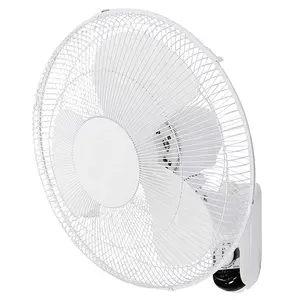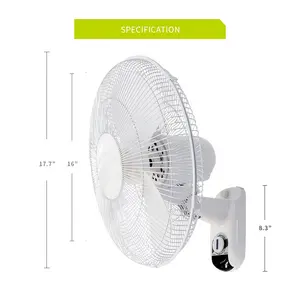Types of Wall Bracket Fans
A wall bracket fan or wall fan is an electric fan that is mounted on a wall using brackets. It consists of several rotating blades powered by an electric motor that creates airflow when it spins. The fan is attached to the wall with brackets, eliminating the need for a stand or base. This design allows installation in rooms with limited floor space. Wall bracket fans provide a cooling breeze and are often used indoors as well as outside. They offer the benefit of increased air circulation.
Wall fans come in various designs and sizes to suit diverse environments. These include;
- FXP Wall Fan: FXP is a renowned brand of fans that are energy-efficient and quiet when operating. They offer reliable cooling solutions for both home and office spaces. FXP wall bracket fans are designed to provide maximum airflow. The materials used to construct the fans are highly durable. They also come in different sizes, so one may opt for a smaller or bigger one depending on the space requirements.
- Havells Wall Fan: In India, Havells is a leading manufacturer of electrical equipment. The wall bracket fans from this manufacturer are known for their quality and superior performance. To cater to diverse markets, they come in various designs and speed options. Some also have remote controls to enhance convenient operation.
- Orbit Wall Fan: Orbit fans are quite popular in offices and homes. They come in numerous sizes and models, including programmable fans that are equipped with timers.
- Frizio Wall Fan: This brand produces industrial wall fans. Frizio fans are built to withstand tough working conditions, making them ideal for warehouses, workshops, and factories.
- Wall-mounted Bracket Fan: These generic fans feature adjustable oscillation functions for improved airflow distribution.
Functions and Features of Wall Bracket Fans
- Space-efficient cooling: The primary function of a wall fan bracket is to secure the fan to the wall, which makes the wall-mounted fan different from the other type of fans. Because it doesn't take up space on the floor, it hangs on the wall. Hence, wall fans are more space-efficient than other types of fans. This helps keep areas organized and clutter-free. Additionally, it allows easy cleaning of the ground.
- Adjustable angle: A wall bracket fan typically comes with an adjustable angle. This feature enables the fan's position to be changed as necessary to direct air toward a specific location.
- Space-saving design: A wall fan bracket is designed to hold wall fans on the wall. Therefore, brackets are more space-efficient than other types of fans because they don't take up space on the floor. It also keeps areas organized and clutter-free.
- Durable material: Wall brackets for fans are usually made of durable material like iron, so they can last for a long time without getting damaged. Their sturdy build can withstand the weight of the fan and hold it securely in place.
- More energy-efficient: Fans are more energy-efficient than other types of machines used to cool down a room. Because they use less energy to operate, they are quite economical and easy on the pockets.
- Quiet operation: Fans usually operate more silently than air conditioning units because their operation is quite silent. For this reason, fans are more preferred in places like bedrooms and study rooms, where peace and quiet are important.
- Improved air circulation: Like wall-mounted air conditioners, wall fans improve air circulation in a room because they distribute air better. This helps distribute air evenly throughout a space, so there are no hot or cold spots.
- Low maintenance: Wall-mounted fans require less maintenance compared to other cooling devices like ACs. The fans' simple mechanism makes their upkeep easy and straightforward.
Applications of wall bracket fans
Wall bracket fans are versatile cooling solutions with numerous residential and commercial applications. Here's more on the uses of wall-mounted fans.
- Residential use: Homeowners use wall bracket fans in various living areas, including bedrooms and dining areas, to improve airflow. These fans are also popular in large, stuffy areas like garages, workshops, and basements for additional cooling. Some homeowners use wall-mounted fans in outdoor patios and decks for a refreshing breeze during warm evenings or get-togethers.
- Offices: Wall-mounted fans are common in offices and have been used in corridors, waiting areas, and large working spaces. They provide extra air circulation that contributes to a more comfortable working environment. Business owners on a budget seeking to improve their office's air conditioning often turn to wall-mounted fans.
- Classrooms: In areas with warm climates or insufficient air conditioning, educators use wall bracket fans to make learning environments more comfortable. They help cool down stuffy classrooms, particularly during long lessons or when a large number of students are present. Also, the fans create a more pleasant atmosphere for both teachers and students. Since they're installed on the wall, they won't obstruct movement, thus maintaining order in the corridors and classrooms of a school. Their cost-effective nature makes them a suitable choice for schools with tight budgets.
- Gyms: When working out, people often seek relief from the heat and wall fans help with that. They are generally installed high on the walls to distribute cooling evenly across the gym. The fans enhance air circulation, which helps to cool the gym and make working out more comfortable. Wall-mounted fans are also a great alternative to ceiling fans as they are easier to install and maintain. Additionally, they don't interfere with other gym equipment or activities since they stay out of the way.
- Industrial settings: In warehouses, factories, and workshops, people use wall bracket fans to make large, stuffy areas more comfortable. These fans cool high-temperature places like kitchens or canneries. Installation is easy because most wall-mounted fans stay on the wall instead of the ceiling. Even after a long time, they don't need much upkeep. Depending on how harsh the workplace is, fans should be serviced after 1 to 2 years. Arrange the fan blades at a 45-degree angle for the best cooling. More air will be moved around the room this way.
- Events and outdoors: Event organizers strategically place wall-mounted fans at concert tents, fairs, and sporting events to keep anticipated crowds cool. They are often used in outdoor settings to enhance air circulation and maintain the comfort of attendees. Party planners use these fans to provide consistent cooling in celebration areas, especially during hot weather.
How to choose wall bracket fans
Selling a fan wall mount requires careful consideration of the type of customers and their preferences. Here are several factors to consider when choosing a fan for resale.
-
Customer Needs
Identifying the target market is vital to choosing customers who prefer specific types of fans. For instance, contractors may prefer fans whose angle can be adjusted, while homeowners may prefer fixed-angle fans.
-
Wall Fan Bracket
The wall fan bracket affects the fan's stability while mounted on the wall. A sturdy, corrosion-resistant bracket made of plastic or galvanized steel can support any wall-mounted fan's weight.
-
Wall Mount Fan Size
Small fans are suitable for compact spaces, while medium and large fans can be used in spacious areas. It is important to consider the size of the walls where the fans will be mounted.
-
Noise Level
Selecting fans with low noise levels is essential for customers who hate noisy equipment. Wall bracket fans with AC motors produce more noise than DC motors. However, the price of fans with DC motors is higher than AC motor fans.
-
Energy Consumption
Energy Efficiency, or the fan's energy usage, is essential for businesses seeking fans with the lowest operating costs. Look for fans with energy-efficient and efficient electric motors.
-
Fan Material
The material of the fan blades, body, and guards affect its durability and maintenance. Plastic brackets are lighter and rust-resistant, while metal brackets are stronger but more prone to corrosion. Steel and metal brackets are heavier than both materials, but have greater longevity. Plastic and metal blades are lightweight, but can't withstand heavy use. For pets or areas with high air traffic, choose fans with metal blades. Fans with metal parts need annual lubrication to prevent rusting.
Q&A
Q1: What are the benefits of a wall-mounted fan over the wall bracket?
A1: A wall-mounted fan secured with a wall bracket fan doesn't need a wall bracket fan installation. It's easy to install, take down, and clean. Also, it saves space on the floor or walls and offers more spacious places for movement and activities.
Q2: How much weight can a fan bracket support?
A2: The weight capacity of a fan bracket depends on the material and design. Generally, quality brackets made from steel or iron with dense and thick materials can support up to 30 kg or more. To get more specific capacity information, it's better to consult the supplier or check the product specifications.
Q3: Can fan brackets be adjusted to change the fan's position?
A3: Some fan brackets can have their position adjusted. This allows the fan to be positioned in various directions. However, not all brackets have this function. So, B business buyers must check the product specifications or consult with the supplier to find out if the fan brackets have adjustable functionality.
Q4: Are fan brackets compatible with any fans?
A4: Fan brackets are designed to be compatible with specific standard dimensions and mounting hole patterns of fans. Nonetheless, different brackets are made for various types of fans, such as computers, wall-mounted fans, and more. So, buyers must ensure they get the right bracket for the specific fan they intend to use.





















































